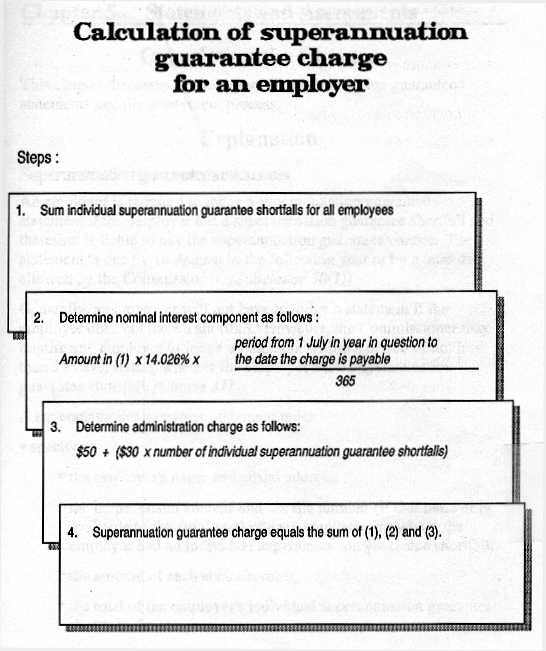Explanatory Memorandum
(Circulated by the authority of the Treasurer, the Hon John Dawkins, M.P.)Chapter 4 Calculation of the Charge
Overview of the Chapter
This chapter sets out the procedure for calculating the amount of superannuation guarantee charge payable once liability for the charge has been determined.
Explanation
Liability for the superannuation guarantee charge
An employer is liable to pay the superannuation guarantee charge which is imposed on the employer's superannuation guarantee shortfall in a year. The charge will be imposed by the Superannuation Guarantee Charge Bill 1992. The amount of the superannuation guarantee charge payable is equal to the amount of the employer's superannuation guarantee shortfall in the year. [Clause 16 of the Superannuation Guarantee (Administration) Bill 1992 and Clauses 5 and 6 of the Superannuation Guarantee Charge Bill 1992]
Calculation of the superannuation guarantee shortfall
An employer's superannuation guarantee shortfall is the sum of:
Total of the employer's individual superannuation guarantee shortfalls for the year
plusEmployer's nominal interest component for the year
plusEmployer's administration component for the year.
[Clause 17]
Total of the employer's individual superannuation guarantee shortfalls
The total of the employer's individual superannuation guarantee shortfalls for the year is the sum of all such individual shortfalls. The calculation of these individual shortfalls is set out in Chapter 3.
Employer's nominal interest component
The employer's nominal interest component is a proxy for investment earnings the employee would have received had the employer provided adequate superannuation support for the employee during the year. The interest is calculated by applying the rate of interest on underpayments and overpayments of income tax to the total of the employer's individual superannuation guarantee shortfalls for the year. The interest is calculated from 1 July of the year in question to the date the charge is payable (i.e., 14 August in the following year, or the date of lodgement of the employer's statement, whichever is the later). The rate of interest is set out in the Taxation (Interest on Overpayments) Act 1983. The rate at present is 14.026% per annum.
Although for the 1993-94 year and subsequent years an employer will determine if they have an individual superannuation guarantee shortfall on a monthly basis, the nominal interest component will still be calculated from 1 July in the year in question to the date the charge is payable. [Clause 28]
Example
Assume the employer has total employer individual superannuation guarantee shortfalls of $5000 and lodges a superannuation guarantee statement on 14 August 1993.
The employer's nominal interest component is as follows:
$5000 * (14.026/100) * (410/365) = $787.76
If the employer did not lodge until 1 September 1993 the employer's nominal interest component will be as follows:
$5000 * (14.026/100) * (428/365) = $822.35
Employer's administration component
The purpose of the employer's administration component is to assist in recovering costs the Australian Taxation Office incurs in administering the Bill. The amount of the employer's administration component has initially been set at $50 plus $30 for each employee for whom the employer has an individual superannuation guarantee shortfall. [Clause 29]
Example
Assume an employer has individual superannuation guarantee shortfalls in respect of seven employees. The employer's administration component will be calculated as follows:
$50 + (7 * $30) = $260
diagram 4.1 sets out the steps in calculating an employer's superannuation guarantee charge.
Example of Calculations in Chapter 3 and 4
Facts:
- •
- In the 1992-93 year the employer had two employees
- •
- the annual national payroll for the 1991-92 year is less than $500,000
- •
- Employee A
- -
- received gross salary and wages of $30,000
- -
- employed under an industrial award where the earnings base for contribution purposes is ordinary time earnings
- -
- ordinary times earnings for the year were $25,000
- •
- Employee B
- -
- received gross salary and wages of $28,000
- -
- employed under an industrial award where the earnings base for contribution purposes is ordinary time earnings
- -
- ordinary time earnings for the year were $25,000
- •
- Under the award the employer should be contributing 3% of ordinary time earnings. However, the employer contributes $10 a week (i.e., $520 per year) for each employee to a complying superannuation fund - the benefits are fully vested and preserved.
Calculation of superannuation guarantee shortfall
- 1.
- Expected Level of Support
- As the employer has an annual national payroll of less than $500,000 the charge percentage for the 1992-93 year is 3%.
- 2.
- Level of support being provided
Employee A ($520 / $25000) = 2.08%
Employee B ($520 / $25000) = 2.08% - 3.
- Individual superannuation guarantee shortfalls
Employee A ((3 - 2.08) / 100) * $30000 = $276
Employee B ((3 - 2.08) / 100) * $28000 = $258 - 4.
- Total individual superannuation guarantee shortfalls
Employee A $276 Employee B 258 Total $534 - 5.
- Nominal interest component
($534 * 14.026%) * (410 / 365) = $84
(410 days from 1 July 1992 to 14 August 1993 - based on an assumption that the employer lodges by the due date) - 6.
- Administration component
$50 + ($30 * 2) = $110 - 7.
- Total charge payable
Total individual superannuation guarantee shortfalls $534 Nominal interest component 84 Administration component 110 TOTAL CHARGE PAYABLE $728

